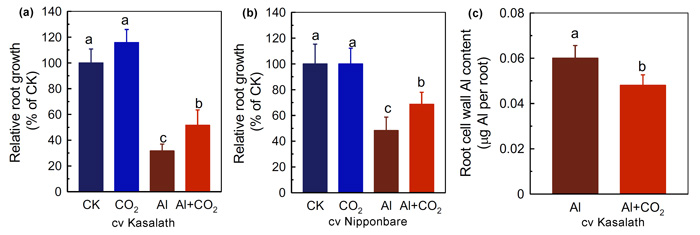| Follow @co2science |
Paper Reviewed
Zhu, X.F., Zhao, X.S., Wang, B., Wu, Q. and Shen, R.F. 2017. Elevated carbon dioxide alleviates aluminum toxicity by decreasing cell wall hemicellulose in rice (Oryza sativa). Frontiers in Physiology 8: 512, doi: 10.3389/fphys.2017.00512.
Setting the stage for their study, Zhu et al. (2017) note that aluminum (Al) is the most abundant metal on earth. When present in significant quantities in the soil, it can be detrimental to plant growth, disrupting physiological and molecular properties. In many instances, aluminum toxicity inhibits root elongation, even at very low concentrations, making it difficult for plants to acquire nutrients, thus leading to a reduction in both the magnitude and quality of their growth.
To date, there has been surprisingly little research conducted on the response of plants to aluminum stress under elevated atmospheric CO2 conditions. Therefore, Zhu et al. set out to investigate the interactive effects of elevated CO2 and aluminum toxicity on one of the most important global food crops -- rice (Oryza sativa).
Working with two subspecies cultivars (ssp. indica, cv Kasalath and ssp. japonica, cv Nipponbare), the five Chinese scientists subjected 3-day-old seedlings to 24-hour treatments of one of two CO2 concentrations (400 or 600 ppm) and one of two aluminum solutions (no added aluminum or 50 µM aluminum added) in a controlled environment chamber, measuring a number of physiological and molecular parameters before and after the treatments to discern the impacts of these two growth-competing variables. And what did their experiment reveal?
As shown in the left and center panels of the figure below, acting alone, aluminum toxicity inhibited root growth in both cultivars, relative to control conditions, by 69 percent in Kasalath and 52 percent in Nipponbare. Elevated CO2, in contrast, stimulated root growth in Kasalath, but had no impact on Nipponbare. In the combined treatment, elevated CO2 ameliorated the negative impacts of aluminum toxicity on root growth, causing a smaller 49 and 32 percent reduction in root growth relative to control in the Kasalath and Nipponbare cultivars, respectively.
Searching for the potential mechanism responsible for the reduction in aluminum toxicity by elevated CO2, Zhu et al.'s additional analyses revealed that "elevated CO2 significantly reduced aluminum retention in the [root] cell wall (see figure 4c), which in turn increased aluminum resistance in rice, indicating the operation of the cell-wall-based aluminum exclusion mechanism." And, therefore, the authors conclude that "elevated CO2 can alleviate aluminum toxicity in rice," which is an important phenomenon for them to have observed.

Figure 1. Effects of elevated CO2 on the relative root growth of cultivars Kasalath (Panel A) and Nipponbare (Panel B) on three-day-old rice seedlings that were treated with 0.5 mM CaCl2 solution with or without 50 µM Al under ambient (400 ppm; CK) or elevated (600 ppm; CO2) CO2 for 24 h (pH 4.5). Root length was measured before and after treatment. Panel C shows the effects of elevated CO2 treatment on root cell wall Al accumulation in Kasalath under the same treatment conditions. Columns with different letters are significantly different at P < 0.05. Adapted from Zhu et al. (2017).




